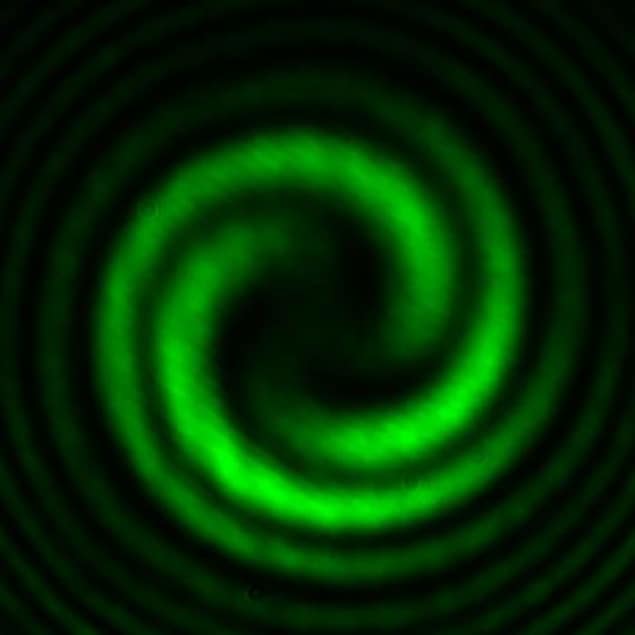
Researchers in the US have created metasurfaces that can switch the orbital angular momentum (OAM) of transmitted light between any two states simply by changing the polarization of light incident on the materials. The metasurfaces offer a simple and practical way to produce “twisted light” with OAM, which has a range of applications from the mechanical manipulation of tiny objects to quantum communications.
The angular momentum of light is the sum of two independent components. One is the more familiar spin angular momentum (SAM) associated with circularly polarized light. It arises from the electric and magnetic field vectors of light rotating over the course of a wavelength. SAM can be produced easily by firing plane polarized light through a crystal slab called a quarter wave plate. However, SAM is of limited practical use because it can only have two values – right or left circular polarization.
OAM of light was first measured in 1992 and is the result of the rotation (or twisting) of a light wave’s phase around the axis of a beam. In principle, OAM can take any integer value and this makes it very useful for a wide range of potential applications. It can be used, for example, to trap tiny particles and set them rotating at a very fast rate in a device called an “optical spanner”. In addition, as waves with different OAM are orthogonal, researchers are already developing ways that light in different OAM states can be used to send an unlimited number of multiplexed data signals along an optical fibre with no crosstalk.
Challenging production
Producing OAM states, however, is challenging. Various techniques exist, but their efficiency – the proportion of the light that is converted into the desired angular momentum state – is sometimes limited, and they do not allow easy switching between different angular momentum states, which would be necessary for multiplexing, for example.
In 2006, the optical physicist Lorenzo Marrucci of the University of Naples Federico II in Italy and colleagues designed a device called a q-plate, which flips the polarization of incident light. During this process SAM is removed from the light and transformed into OAM. Q-plates channel light into the correct OAM state, with up to 100% efficiency, and the state can be changed simply by flipping the SAM of the incident beam. However, q-plates only work with pure right or left circularly polarized light, whereas light beams often have intermediate “elliptical polarization”. Moreover, they can produce only two possible output states: a fixed amount of OAM is added to one spin state; an equal and opposite amount is added to the other spin state.
Federico Capasso and colleagues at Harvard University in the US worked out the most general mathematically possible transformation a surface could perform from two input polarizations to two output OAM states. “It turns out no traditional material can produce this required effect,” says Harvard’s Robert Devlin. Therefore, the researchers designed artificial metasurfaces comprising thousands of nanometre-scale titanium oxide pillars. The metasurface can be designed such that any two equal and opposite input polarization states are each transmitted into any output OAM states whatsoever.
Working on the beam
The total angular momentum of the beam need not be conserved because the metasurface can do work on the beam. “If we had a really, really small device and a very intense beam coming in then, for all of these cases where there isn’t a perfect transfer from spin to orbital angular momentum, you would actually see the device itself start to spin,” explains Devlin. This can allow the production of states with output OAM greater than the limit quantum mechanics places on the input SAM.
Previously, similar transformations would have entailed passing light through several optical components in succession: “Now that the device has been distilled down to a single component, rather than eight or so elements on an optical table, one can directly integrate the single device into a variety of areas, and there is the potential for new experiments and applications in communications and quantum optics,” says Devlin. “Where it ultimately goes, what it ultimately gets used for and whether it enables some completely new functionality – that’s the exciting part that we’re exploring now.”
Marrucci, who was not involved in the research, is enthusiastic: “Metamaterials have been around for a while, but most of the work was with plasmonic metals, which are lossy and hence not so convenient,” he says, “I think the main advance here is to demonstrate what can be done with dielectric metamaterials. This specific demonstration of arbitrary spin to orbital angular momentum conversion shows they can do something not easily done with different technologies. I wouldn’t say this specific optical effect is particularly important fundamentally, but the paper brilliantly demonstrates the huge potential of this novel technology,” he says.
The research is described in Science



